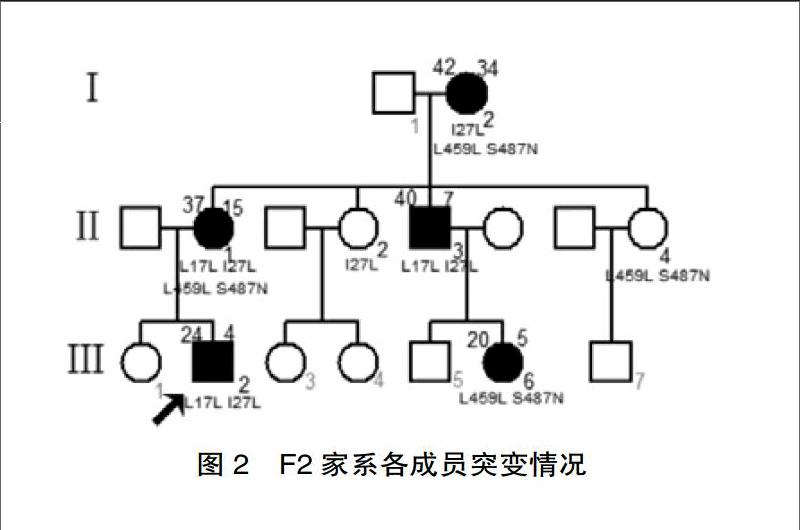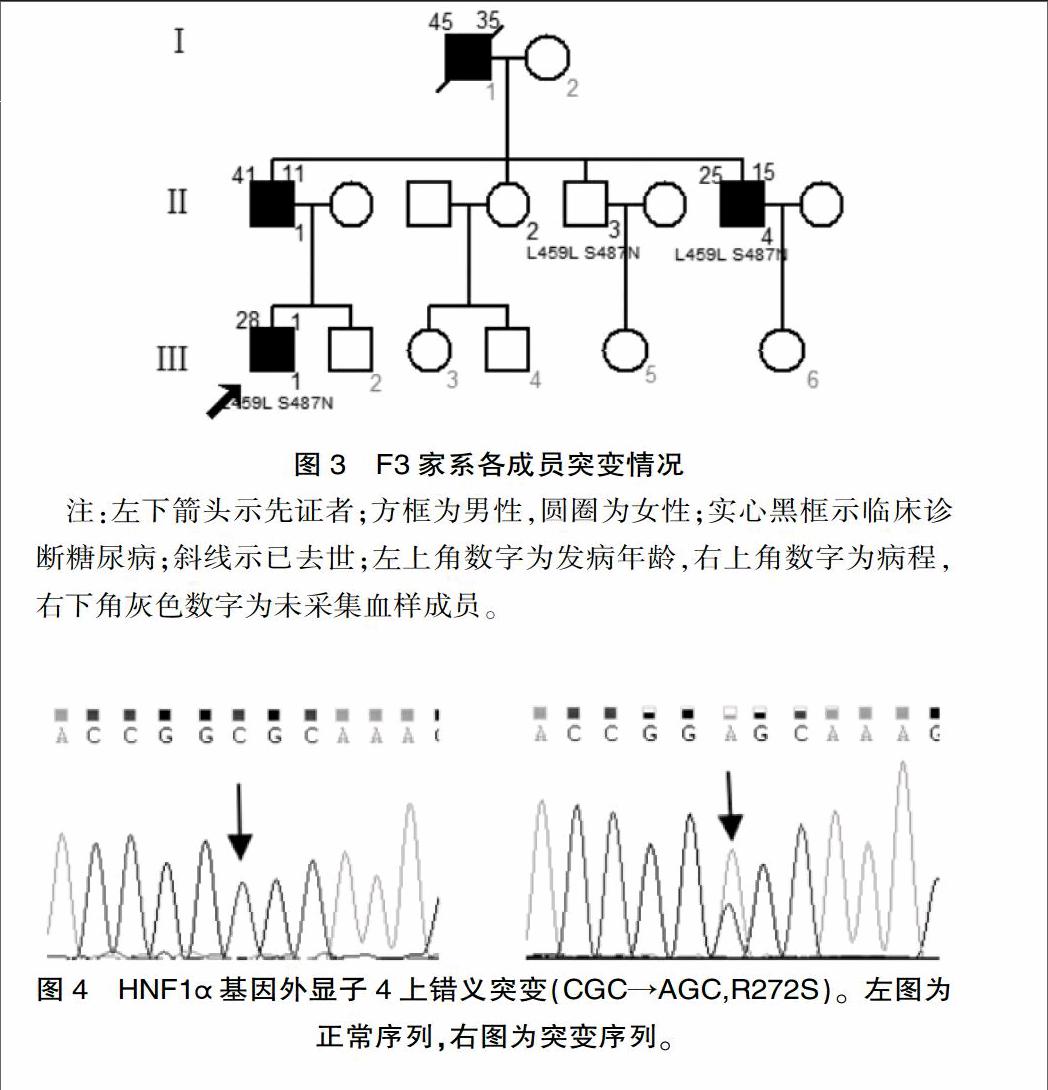3个早发糖尿病家系HNF1α基因筛查研究
2017-06-28康晓丽丁文宇张勇赵珂王志
康晓丽++丁文宇++张勇++赵珂++王志斌++王尧++郭振奎



DOI:10.16658/j.cnki.1672-4062.2017.05.005
[摘要] 目的 通过对3个疑为MODY3的早发糖尿病家系成员HNF1α基因分子筛查,探讨该基因分子缺陷是否为其主要发病因素。方法 抽取家系成员外周血,应用聚合酶链式反应技术对HNF1ɑ基因全部外显子及外显子内含子拼接区进行扩增,PCR产物直接测序,测序结果与NCBI数据库中标准序列比对分析。结果 发现3个编码区错义突变:R272S、I27L、S487N,2个同义突变:I17L、L459L,6个非编码区碱基改变:IVS1+91A>G、IVS5+9C>G、IVS7+7G>A、IVS8-24T>C、IVS9+197G>T、IVS9+438G>A。R272S在F1家系中的分布与糖尿病的发生共分离;除R272S外的其他碱基改变均为多态性改变,且和糖尿病的发生无明显相关性。结论 该研究发现10个多态性位点; R272S突变在F1家系中与糖尿病的发生共分离,初步判断该家系是由突变R272S导致的MODY3家系。
[关键词] 青少年的成人起病型糖尿病(MODY);HNF1α;R272S;突变;多态性
[中图分类号] R587 [文献标识码] A [文章编号] 1672-4062(2017)03(a)-0005-03
Research on Screening of 3 Familial Early-onset Diabetes Pedigrees HNF1α Genes
KANG Xiao-li1,2, DING Wen-yu2, ZHANG Yong2, ZHAO Ke2, WANG Zhi-bin2, WANG Yao2, GUO Zhen-kui2
1.College of Medicine and Life Science of Shandong Academy of Medical Sciences of Jinan University,Jinan,Shandong Province, 250000 China;2.Institute of Endocrinology and Metabolism of Shandong Province,Jinan,Shandong Province, 250000 China
[Abstract] Objective To screen 3 familial early-onset diabetes pedigrees HNF1α genes and study whether the gene molecule defect is the major pathogenic factor. Methods The peripheral blood of families was extracted and the all exons and exon and intron split joint center were expanded by the polymerase chain reaction, and the PCR products sequence results and standardized sequence in NCBI database were compared and analyzed. Results 3 code area missense mutations were found: R272S,I27L,S487N, 2 samesense mutations: I17L and L459L, 6 noncoding region basic group changes: IVS1+91A>G, IVS5+9C>G, IVS7+7G>A, IVS8-24T>C, IVS9+197G>T, IVS9+438G>A, and there was a coseparation distribution of R272S in the F1 family and occurrence of diabetes, and other basic group changes were polymorphisms changes in addition to R272S, and there was no obvious correlation with the occurrence of diabetes. Conclusion The research shows that there ae 10 polymorphic sites, and R272S mutation has a coseparation with the occurrence of diabetes, and we can initially determine that the family is the MODY3 family caused by R272S mutation.
[Key words] MODY; HNF1α; R272S; Mutation; Polymorphism
青少年起病的成人型糖尿病3型(MODY3)由HNF1α基因突變所致,该基因定位在12q24.2,在肝脏、肾脏、肠、β细胞中均有表达,是调控胰岛素分泌的关键转录因子,至今已发现了近200种HNF 1α基因突变[1]。该研究对3个家系共26例样本的HNF1α外显子及拼接区进行直接测序,探索其碱基改变与糖尿病发生的关系,以期能发现新的MODY3基因致病位点。
1 对象与方法
1.1 对象
选取3个疑为MODY3的早发糖尿病家系,分别用F1、F2、F3来表示,先证者均为就诊于山东内分泌与代谢病医院的糖尿病患者,均为山东地区汉族居民,共有特点:①发病年龄小于45岁;②家族中至少两代为糖尿病患者;③病初服用磺脲类药物治疗效果较好;④胰岛细胞抗体和谷氨酸脱梭酶抗体阴性;⑤BMI多正常。
現收集F1家系15例、F2家系7例、F3家系4例的外周血进行该基因研究。其中包括F1家系中糖耐量异常者2例(Ⅰ1、Ⅲ6)。(各家系成员血样采集情况及发病情况见图1、2、3)选择无亲缘关系的健康人16名作为对照,男性8名,女性8名,无糖尿病家族史,平均年龄(40.12±19.37)岁,体重指数(23.60±3.97)kg/m2。
1.2 方法
经伦理委员会及患者知情同意后,提取3个家系中26例成员的外周血DNA,PCR扩增HNF1α基因全部外显子及外显子与内含子拼接区。将检测出目的片段的未纯化PCR产物送到华大基因直接测序。
2 结果
该研究中发现3个编码区错义突变:R272S、I27L、S487N,2个同义突变:I17L、L459L,6个非编码区碱基改变:IVS1+91A>G、IVS5+9C>G、IVS7+7G>A、IVS8-24T>C、IVS9+197G>T、IVS9+438G>A。上述碱基改变均于F1家系中发现,并且R272S、IVS5+9C>G、IVS8-24T>C、IVS9+197G>T、IVS9+438G>A只出现于该家系中;其他4种编码区碱基改变及2种非编码区碱基改变均于3个家系及健康对照组检出。F1家系中糖代谢异常的9名成员均携带HNF1α基因4号外显子杂合突变c.814C>A,该突变位点导致第272位氨基酸由精氨酸突变为丝氨酸(R272S,突变测序图见图4),其中除R272S外的其他碱基改变均可在NCBI中查到相关SNP信息,且和糖尿病的发生无明显相关性,而错义突变R272S在F1家系中与糖尿病的发生共分离(测序成员携带的编码区突变见图1、2、3)。
3 讨论
该研究结果显示R272S突变在F1家系中与糖尿病的发生共分离。该突变位于HNF1α基因的DNA结合区,该区的基因突变可导致转录因子与靶基因结合异常,影响靶基因转录。而它的靶基因包括胰岛素分泌相关的基因和糖代谢相关的基因等。R272S在国外的文献中出现过[2],但未对其做出功能分析,国内尚未见该位点的报道。Prabi预测网站分析显示该突变致使其二级结构由α螺旋变为不规则卷曲及延伸链,这种改变极有可能形成新的活性位点,导致蛋白功能改变。另外,应用蛋白功能预测网站都显示R272S突变有较强的致病性。
该研究尚发现4种编码区突变,即I27L、S487N、I17L、L459L,这4种多态性位点已在印度[3]、泰国[4]、墨西哥[5]、欧洲[6]也有所报道。Holmkvist等[7]研究发现I27L、S487N与口服葡萄糖后胰岛素分泌的减少有关,而Urhammer等[8]的研究发现I27L、S487N两种多态性胰岛素分泌无相关性。在该研究中,未发现这4种编码区突变与糖尿病相关的证据,并且在健康对照组中亦有较高的检出率,分别为0.69、0.69、0.875、0.875。
综上,该研究发现10种多态性位点;R272S在F1家系中与糖尿病的发生共分离,初步判断HNF1α为该家系糖尿病发生的致病基因。
[参考文献]
[1] S. Ellard,K. Colclough, Mutations in the genes encoding the transcription factors hepatocyte nuclear factor 1 alpha (HNF1A) and 4 alpha (HNF4A) in maturity onset diabetes of the young[J].Hum Mutat, 2006,27(9):854-869.
[2] Bellanne-Chantelot C, Carette C, Riveline J P, et al. The type and the position of HNF1A mutation modulate age at diagnosis of diabetes in patients with maturity-onset diabetes of the young (MODY3)[J]. Diabetes,2008,57(2):503-508.
[3] Radha V, EK J, Anuradha S, et al. Identification of novel variants in the hepatocyte nuclear factor-1α gene in South India patients with maturity onset diabetes of young[J].J Clin Endocrinol Metab,2009,94(6):1959-1965.
[4] Plengvidhya N, Boonyasrisawat W, Chongjaroen N, et al. Mutations of maturity-onset diabetes mellitus[J].Clin Endocrinol,2009,70(6):847-835.
[5] Doningue-Lopez A, Miliar-Gareia A, Segura-Kato Y X, et al. Mutations in MODY genes are not common cause of early-onset type2 diabetes in Mexican families[J].JOP,2005,6(3):238-245.
[6] Yamagota K, Oda N, Kaisaki P J, et al. Mutations in the hepatic nuclear factor-1alpha gene in maturity-onset diabetes of the young (MODY3)[J]. Nature,1996,384(6608):455-458.
[7] Holmkvist J,Cervin C,Lyssenko V,et al.Common variants in HNF1alpha and risk of type2 diabetes[J].Diabetologia,2006,49(12):2882-2891.
[8] Urhammer S A, Moller A M, Nyholm B, et al. The effect of two frequent amino acid variants of the hepatocyte nuclear factor-1 alpha gene on estimates of the pancreatic beta-cell function in Caucasian glucose-tolerant first-degree relatives of type 2 diabetic patients[J].J Clin Endocrinol Metab,1998, 83(11):3992-3995.
(收稿日期:2016-12-02)
